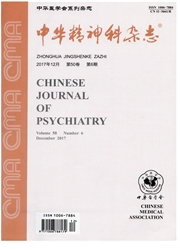

 中文摘要:
中文摘要:
目的调查我国海洛因依赖者中《美国精神障碍诊断与统计手册(第4版)》(DSM—IV)轴I精神障碍和其他物质使用障碍的终身患病情况。方法对湖南省3家戒毒机构的1002例海洛因依赖者进行横截面调查;采用自制调查表收集一般资料;采用《DSM—IV-TR轴I障碍定式临床检查患者版》(SCID—I/P)调查DSM.IV轴I障碍的终身患病情况。结果1002例海洛因依赖者中,共病心境障碍191例,终身患病率为19.1%,主要诊断是重性抑郁障碍135例,占13.5%;共病焦虑障碍128例,终身患病率为12.8%,主要诊断是创伤后应激障碍81例,占8.1%;有579例(57.8%)患有其他物质使用障碍,其中以镇静催眠抗焦虑药使用障碍和酒精使用障碍最常见,分别为303例(30.3%)和275例(27.5%),兴奋剂使用障碍和致幻剂使用障碍也较常见,分别为148例(14.8%)和127例(12.7%)。结论我国海洛因依赖者的共病和其他物质使用障碍的情况非常普遍,应得到高度的关注和相应的诊治。
 英文摘要:
英文摘要:
Objective To provide lifetime rates of axis I comorbidities of the fourth edition of the Diagnostic and Statistical Manual of Mental Disorders (DSM-IV) among patients with heroin dependence. Methods A cross-section study was conducted. Subjects were 1002 heroin-dependent patients who were consecutively admitted into three drug rehabilitation settings in Hunan province. A questionnaire was developed to get demographic and drug use-related information of the subjects. Structured Clinical Interview for DSM-IV-TR Axis I Disorders-Patient Edition (SCID-I/P ) was used for making lifetime DSM-IV axis I diagnoses. Results Among the subjects, mood disorder was the most common type of co- occurring axis I non-substance use mental disorders (191,19. 1% ), followed by anxiety disorder (128, 12. 8% ). Major depression (135,13.5%) was the most common diagnosis among co-occurring mood disorders, whereas post-traumatic stress disorder (PTSD, 81,8. 1% ) was the most common diagnosis among anxiety disorders. 579 (57.8%) subjects had other substance (non-opioid, other than tobacco) use disorders. The most frequent diagnoses of other substance use disorders were sedative-hypnotics use disorder and alcohol use disorder, with lifetime rates of 30. 3% (303) and 27.5% (275) respectively, followed by stimulant and hallucinogen use disorder, with a lifetime rate of 14. 8% (148) for stimulant use disorder and a lifetime rate of 12. 7% ( 127 ) for hallucinogen use disorder. Conclusions Co-occurring non-substance use mental disorders and other substance use disorders among heroin-dependent patients in China are highly prevalent, to which great importance should be attached in the process of diagnosis and treatment.
 同期刊论文项目
同期刊论文项目
 同项目期刊论文
同项目期刊论文
 期刊信息
期刊信息
